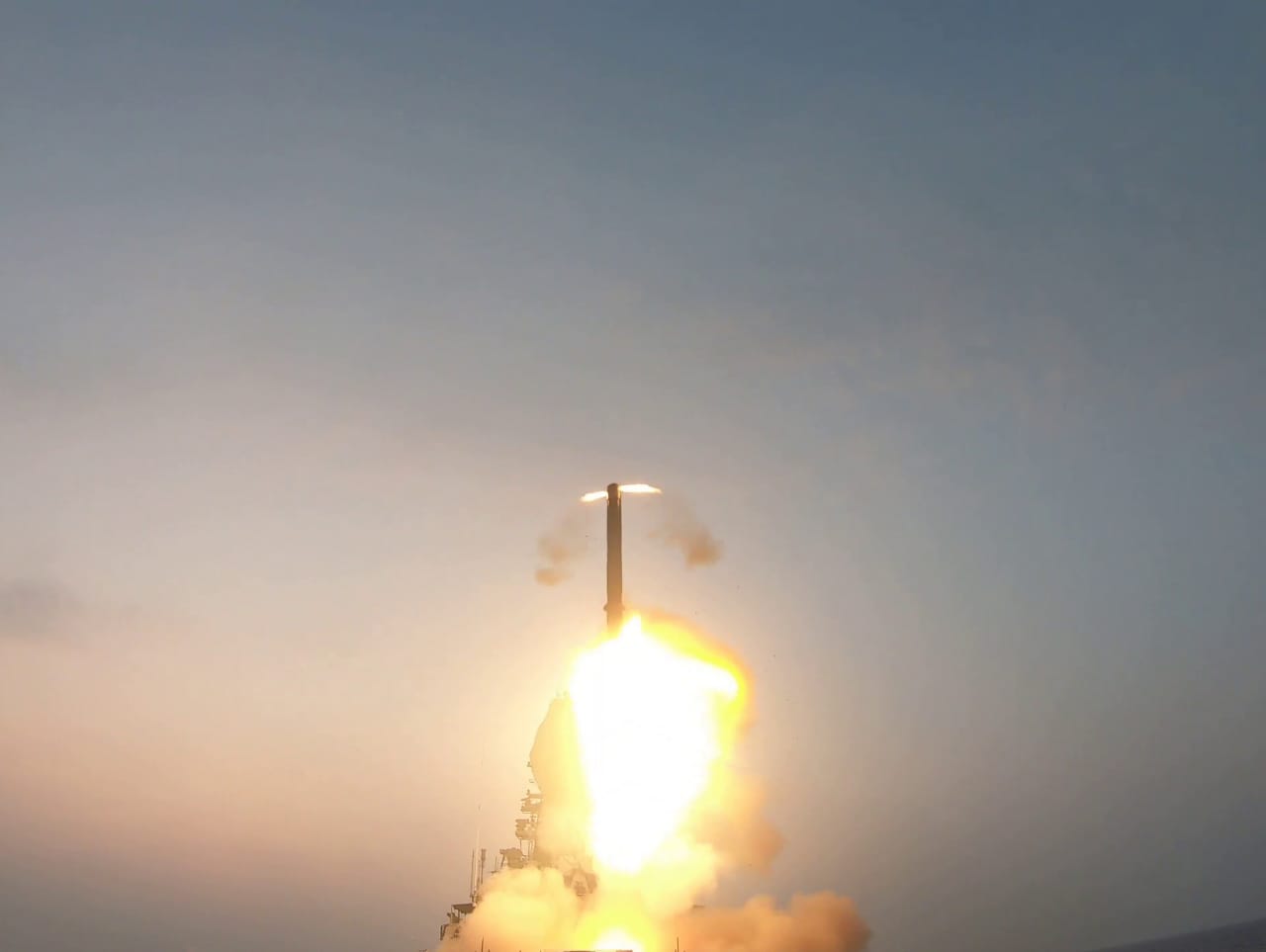After ending 2021 on a high note, India’s Defence Research and Development Organisation (DRDO) ushered in the New Year with the successful testing of the BrahMos supersonic cruise missile and the man-portable anti-tank guided missile (MPATGM).
Chinese ‘Moon-Walk’ On Earth! Beijing Says Developing Zero Gravity Conditions On Earth With Ambitious Lunar Project
The Indian Navy’s newly commissioned INS Visakhapatnam test-fired an extended range sea-to-sea variant of the BrahMos missile on January 11.

“Advanced sea to sea variant of BrahMos Supersonic Cruise missile was tested from INS Visakhapatnam today. The missile hit the designated target ship precisely,” DRDO wrote on Twitter.
Advanced sea to sea variant of BrahMos Supersonic Cruise missile was tested from INS Visakhapatnam today. Missile hit the designated target ship precisely. @indiannavy @BrahMosMissile#SashaktBharat#AtmaNirbharBharat pic.twitter.com/BbnazlRoM4
— DRDO (@DRDO_India) January 11, 2022
The launch was hailed as a success by the Navy. “Successful test-firing of the extended-range BrahMos Supersonic Cruise missile from INS Visakhapatnam, Indian Navy’s newest indigenously-built guided-missile destroyer, represents a twin achievement: Certifies the accuracy of the ship’s combat system and armament complex. Validates a new capability the missile provides the Navy and the Nation,” it tweeted.
INS Visakhapatnam was commissioned into the Indian Navy in November last year. It is the first of the four stealth guided-missile destroyers under Project 15B, Hindustan Times reported previously.
Apart from the BrahMos, INS Visakhapatnam can fire Israeli-made Barak 8 long-range surface-to-air missiles.
Earlier in December 2020, Kolkata-class stealth destroyer INS Chennai and Rajput-class destroyer INS Ranvijay tested the naval variant of the BrahMos in October and December 2020, respectively.
“The robustness of @indiannavy mission readiness is reconfirmed today after successful launch of the advanced version of BrahMos Missile from INS Vishakhapatnam today. I congratulate the wonderful teamwork of @indiannavy @DRDO_India & @BrahMosMissile,” Defense Minister Rajnath Singh tweeted on January 11.
Rafale-M (Marine) OR F-18 Super Hornet: Indian Naval Commander Decodes The Ideal Fighter Aircraft For INS Vikrant
These supersonic missiles, which were first introduced in 2001, can be launched from submarines, ships, aircraft, and land platforms.
Meanwhile, DRDO on January 11 successfully flight tested the final deliverable configuration of man-portable anti-tank guided missile (MPATGM). The indigenously developed ATGM is a low-weight ‘fire and forget’ missile, PTI reported.
Why BrahMos Naval Variant A Game-Changer?
BrahMos, which was originally deployed on Navy warships in 2005, has the potential to hit sea-based targets beyond the radar horizon.
This version of the missile is designed to fire from moving/stationary assets in either a vertical or horizontal mode, targeting both land and water targets. The missiles, which travel at 2.8 Mach, or nearly three times the speed of sound, greatly improve the ships’ ability to engage long-range targets.

The Indian Navy has picked the BrahMos as its primary ship-launched cruise missile, with all frigates and destroyers being built to carry the BrahMos in vertical-launch canisters, with eight missiles per frigate and 16 missiles per destroyer, as previously stated by the EurAsian Times.
India has successfully tested the missile from various platforms since the start of the border standoff with China in May 2020.
The BrahMos supersonic cruise missile’s improved “sea-to-sea variant” has a range of 350 to 400 kilometers, which is more than the other existing version that has a maximum range of 290 kilometers.
The latest missile can be launched horizontally or vertically from a moving or stationary platform, and it can hit both marine and land targets. This adds more versatility to this indigenous missile and increases the ease of launch as well as its maneuverability.
#India successfully test-fired a naval variant of the advanced supersonic #BrahMos cruise missile from a stealth guided-missile destroyer of the #IndianNavy. The DRDO said that the missile hit the designated target "precisely"
Watch the video for more details pic.twitter.com/ZnxEFXME0W
— Hindustan Times (@htTweets) January 11, 2022
The latest test of BrahMos was conducted a day before India and China began their 14 round of military commander-level talks in a bid to find a solution to the protracted border standoff, which has entered its second winter.
While the Indian side is eager for a quick resolution, the Chinese seem to be more interested in a status-quo that gives them more access to territory that is claimed by both sides but falls under the Indian jurisdiction.
BrahMos Could Enable Deterrence In IOR
Chinese presence in the Indian Ocean Region has seen an upward trajectory with the country’s military base in Djibouti and its back-channel entry into the IOR through Pakistan’s Gwadar port.

The new Navy Chief of India, Admiral R Hari Kumar, had earlier said that his force is keeping an eagle eye on Chinese naval forays into the IOR and is fully capable and poised to tackle any security threat.
Indian Navy Sources: Indian Navy aircraft spotted the movement of Chinese distant-water fishing fleet, supported by People's Liberation Army Navy ships, in western Indian Ocean Region when they were moving towards Morocco. pic.twitter.com/tgtKhLlm8q
— ANI (@ANI) January 28, 2020
Defense expert, Col. Ajai Shukla (retired), had previously written that the BrahMos could be useful in the early stages of a conflict with China for pinpoint strikes on heavily defended targets that are too dangerous for manned fighter aircraft to attack, such as airbases, headquarters, key roads, and railways, or logistics dumps.
The rising acrimony between India and China, the conflict at the border, China’s ever-growing maritime fleet, its superior naval power and its transfer of advanced warships and other assets to its all-weather ally Pakistan could be the factors behind India’s continued testing and upgrade of various weapon systems.
Earlier, as EurAsian Times reported, Chinese experts voiced ‘deep concerns’ after the Indian military deployed BrahMos supersonic missiles along the Line of Actual Control (LAC). They appeared to caution New Delhi of “new barriers” in border talks if India proceeded with the transportation of its most advanced missile to the western side of LAC.
Global Customers For BrahMos
The BrahMos is a medium-range ramjet supersonic cruise missile that may be launched from a submarine, ship, plane, or land.
It is considered the world’s fastest supersonic cruise missile. This has been developed by BrahMos Aerospace, a joint venture between NPO Mashinostroyeniya of Russia and India’s DRDO. Both the land-based and ship-based variants are already in use and a hypersonic variant remains under development.
According to reports, numerous Southeast Asian countries, including Thailand, Indonesia, and Vietnam, are interested in the land and sea-based variants of BrahMos. The list of potential buyers also includes Argentina, Brazil, South Africa, the United Arab Emirates and Saudi Arabia
Philippines’ budget department has given money to buy BrahMos – https://t.co/VZj4C6HzEh pic.twitter.com/f48oi1jpzH
— Alert 5 (@alert5) December 30, 2021
The case for supplying BrahMos missiles to the Philippines is already before the Cabinet Committee for Security, which would give the final clearance. The latest test could also be aimed at attracting the attention of prospective customers although the export version of the BrahMos is expected to be of a lower range (280 km).
Lunar Race Heats-Up In 2022 – Why Over 7 Countries Are Headed To Moon Including US, Russia, India & China?
Nitin J Ticku, managing editor and defense expert with The EurAsian Times says BrahMos missiles are easily the ‘exportable’ weapons in the Indian armory much ahead of others including LCA Tejas.
They already are ‘monster missiles’ however once India develops the hypersonic version of BrahMos, this could be another game-changing technology for the Indian military after the acquisition of Russian S-400 systems and French Dassault Rafale fighters.
- Contact the author at sakshi.tiwari9555@gmail.com
- Follow EurAsian Times on Google News




